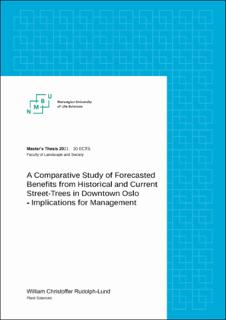| dc.contributor.advisor | Solfjeld, Ingjerd | |
| dc.contributor.author | Rudolph-Lund, William | |
| dc.date.accessioned | 2021-11-15T12:54:05Z | |
| dc.date.available | 2021-11-15T12:54:05Z | |
| dc.date.issued | 2021 | |
| dc.identifier.uri | https://hdl.handle.net/11250/2829593 | |
| dc.description.abstract | Urban trees and forests provide environmental, economic, social, and human health benefits collectively known as ecosystem services. Todays’ climate crisis and urbanization is linked to multiple challenges within cities and green infrastructure. Urban trees can help counteract these problems but must first be recognized as a part of the planning process. Across Europe, tree inventories are increasingly becoming younger and smaller as large trees are removed due to the potential risks they pose to public safety and infrastructure. The new area zoning plan for downtown Oslo (2019) attempts to protect and further develop the city’s current green infrastructure. If managers and urban planners alike are to effectively work towards the “protection and further development” of the green infrastructure in downtown Oslo, it necessitates having a baseline on which to assess what such a development entails.
This study investigates such a baseline by comparing historical and current tree populations for six different sites in downtown Oslo, and their respective benefits after a 50-year forecast run in i-Tree Eco. The overall benefits provided by the current sites after the forecast were 25 %, 33% and 50% for pollution removal, carbon storage and carbon sequestration when compared to the historical trees under a hypothetical scenario of zero mortality. These results were found, despite the existing tree population being 16% larger and not accounting for the high mortalities of 18-40% associated with the establishment of street-trees. These results highlight the importance of preserving large trees.
Managers and urban planners are encouraged to have a holistic approach with target goals that better account for the higher benefits of incorporating larger trees in the municipality’s tree inventory when planning future projects. | en_US |
| dc.language.iso | eng | en_US |
| dc.publisher | Norwegian University of Life Sciences, Ås | en_US |
| dc.rights | Attribution-NonCommercial-NoDerivatives 4.0 Internasjonal | * |
| dc.rights.uri | http://creativecommons.org/licenses/by-nc-nd/4.0/deed.no | * |
| dc.subject | i-Tree | en_US |
| dc.subject | Downtown Oslo | en_US |
| dc.subject | Urban planning | en_US |
| dc.subject | Trees | en_US |
| dc.subject | Ecosystem services | en_US |
| dc.title | A Comparative Study of Forecasted Benefits from Historical and Current Street-Trees in Downtown Oslo. Implications for Management | en_US |
| dc.type | Master thesis | en_US |
| dc.subject.nsi | VDP::Landbruks- og Fiskerifag: 900 | en_US |
| dc.description.localcode | M-PV | en_US |

